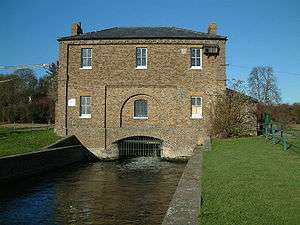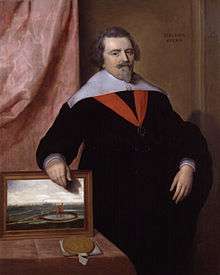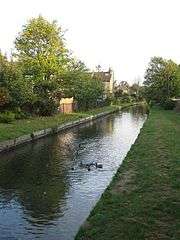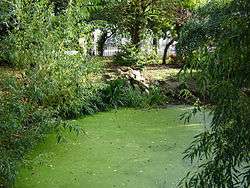New River (London)
The New River is an artificial waterway in England, opened in 1613 to supply London with fresh drinking water taken from the River Lea and from Chadwell Springs and, originally, Amwell Springs,[1] as well as other springs and wells along its course.

The river follows the land contours but certain parts have been straightened over the centuries. Although it was at one time threatened with closure, the waterway continues to supply water to the capital. There is a designated walking route along the canal called the New River Path. It is a 28-mile (45 km) long-distance footpath which follows the course of the New River from its source in Hertfordshire to its original end in Islington, London.
Route
| New River Route | |||||||||||||||||||||||||||||||||||||||||||||||||||||||||||||||||||||||||||||||||||||||||||||||||||||||||||||||||||||||||||||||||||||||||||||||||||||||||||||||||||||||||||||||||||||||||||||||||||||||||||||||||||||||||||||||||||||||||||||||||||||||||||||||||||||||||||||||||||||||||||||||||||||||||||||||||||||||||||||||||||||||||||||||||||||||||||||||||||||||||||||||||||||||||||||||||||||||||||||||||||||||||||||||||||||||||||||||||||||||||||||||||||||||||||||||||||||||||||||||||||||||||||||||||||||||||||||||||||||||||||||
|---|---|---|---|---|---|---|---|---|---|---|---|---|---|---|---|---|---|---|---|---|---|---|---|---|---|---|---|---|---|---|---|---|---|---|---|---|---|---|---|---|---|---|---|---|---|---|---|---|---|---|---|---|---|---|---|---|---|---|---|---|---|---|---|---|---|---|---|---|---|---|---|---|---|---|---|---|---|---|---|---|---|---|---|---|---|---|---|---|---|---|---|---|---|---|---|---|---|---|---|---|---|---|---|---|---|---|---|---|---|---|---|---|---|---|---|---|---|---|---|---|---|---|---|---|---|---|---|---|---|---|---|---|---|---|---|---|---|---|---|---|---|---|---|---|---|---|---|---|---|---|---|---|---|---|---|---|---|---|---|---|---|---|---|---|---|---|---|---|---|---|---|---|---|---|---|---|---|---|---|---|---|---|---|---|---|---|---|---|---|---|---|---|---|---|---|---|---|---|---|---|---|---|---|---|---|---|---|---|---|---|---|---|---|---|---|---|---|---|---|---|---|---|---|---|---|---|---|---|---|---|---|---|---|---|---|---|---|---|---|---|---|---|---|---|---|---|---|---|---|---|---|---|---|---|---|---|---|---|---|---|---|---|---|---|---|---|---|---|---|---|---|---|---|---|---|---|---|---|---|---|---|---|---|---|---|---|---|---|---|---|---|---|---|---|---|---|---|---|---|---|---|---|---|---|---|---|---|---|---|---|---|---|---|---|---|---|---|---|---|---|---|---|---|---|---|---|---|---|---|---|---|---|---|---|---|---|---|---|---|---|---|---|---|---|---|---|---|---|---|---|---|---|---|---|---|---|---|---|---|---|---|---|---|---|---|---|---|---|---|---|---|---|---|---|---|---|---|---|---|---|---|---|---|---|---|---|---|---|---|---|---|---|---|---|---|---|---|---|---|---|---|---|---|---|---|---|---|---|---|---|---|---|---|---|---|---|---|---|---|---|---|---|---|---|---|---|---|---|---|---|---|---|---|---|---|---|---|---|---|---|---|---|---|---|---|---|---|---|---|---|---|---|---|---|---|---|---|---|---|---|---|---|---|---|---|---|---|---|---|---|---|---|---|---|---|---|---|---|---|---|---|---|---|---|---|---|---|---|---|---|---|---|---|---|---|---|---|---|---|---|---|---|---|---|---|---|---|---|---|---|---|---|---|---|---|---|---|---|---|---|---|---|---|---|---|
| |||||||||||||||||||||||||||||||||||||||||||||||||||||||||||||||||||||||||||||||||||||||||||||||||||||||||||||||||||||||||||||||||||||||||||||||||||||||||||||||||||||||||||||||||||||||||||||||||||||||||||||||||||||||||||||||||||||||||||||||||||||||||||||||||||||||||||||||||||||||||||||||||||||||||||||||||||||||||||||||||||||||||||||||||||||||||||||||||||||||||||||||||||||||||||||||||||||||||||||||||||||||||||||||||||||||||||||||||||||||||||||||||||||||||||||||||||||||||||||||||||||||||||||||||||||||||||||||||||||||||||||
It starts between Ware and Hertford in Hertfordshire and today runs 20 miles (32 km) down to Stoke Newington. Among the districts it flows through are (from north to south):
- Great Amwell
- Broxbourne
- Cheshunt
- Enfield
- Palmers Green
- Bowes Park
- Wood Green (passing close to Alexandra Palace)
- Hornsey
- Harringay
- Finsbury Park
Its original termination point was at New River Head near Clerkenwell, Islington, close to the current location of Sadler's Wells theatre — where water from the river was used to flood a large tank to stage an Aquatic Theatre at the beginning of the nineteenth century.[2] In 1946, the water supply to New River Head was truncated at Stoke Newington with the New River ending at the East Reservoir.[3] The reservoir is managed as the Woodberry Wetlands – a nature reserve and designated Site of Metropolitan Importance.
Construction


The design and construction of the New River is often attributed solely to Sir Hugh Myddelton. Edmund Colthurst first proposed the idea in 1602, obtaining a charter from King James I in 1604 to carry it out. After surveying the route and digging the first 2 miles (3 km) stretch, Colthurst encountered financial difficulties and it fell to Myddelton to complete the work between 1609 and its official opening on 29 September 1613. The project was also rescued by the King personally, whose house and lands at Theobalds Park were crossed by the river. James took half of the shares in 1612 for a half of the profits. In order to give the project a firmer legal and financial structure, The New River Company was incorporated in 1619 by Royal Charter, with the assistance of Sir John Backhouse. The company's first reservoir was built on his land in Islington. Myddelton gave some of the shares in the New River Company to Colthurst.
The expense and engineering challenges of the project—it relied on gravity to allow the water to flow, carefully following the contours of the terrain from Ware into London, and dropping around just five inches per mile (8 cm/km)—were not Myddelton's only worries. He also faced considerable opposition from landowners who feared that the New River would reduce the value of their farmland (they argued that floods or overflowing might create quagmires that could trap livestock); others were concerned at the possible disruption to road transport networks between Hertfordshire and the capital. Myddelton, however, was strongly supported by the king, who agreed to pay half the project's expenses in return for a 50% shareholding; such backing quickly silenced the scheme's critics.
When it was originally constructed, long sections, for example around Forty Hall and in Hornsey, wound around the heads of small tributary valleys of the Lea. Other sections of the river, including the one in Harringay, were carried across valleys in wooden aqueducts lined with lead and supported by strong timbers and brick piers. In at least one section, locals referred to the river as the boarded river. Improvements in canal construction in the eighteenth century led to these sections being replaced by clay-banked canals.[4]
New River Company
The New River Company was incorporated by royal charter in 1619 with Sir Hugh Myddleton as first governor. Under the charter, it was a penal offence to throw rubbish or carrion into the river, while anyone washing clothes in it or planting sallow, willow or elm trees within five yards of it would incur the "King's displeasure".[5] The company became a significant landowner in the Clerkenwell district of Islington and laid out streets and squares which take their name from people and places associated with the company, including Amwell Street, River Street, Mylne Street, Chadwell Street and Myddelton Square.
When London's population grew beyond a million inhabitants, the "New River" failed to give an adequate supply of water, and other companies were formed for the purpose of supplying different parts of London: Chelsea Waterworks and others were started by various companies in succession. This company's water was often by commissions found purer than the others. It was also, due to its source, not impacted by the ban on the supply of drinking water from the tidal Thames under the Metropolis Water Act 1852 from 1 August 1855. After this date the company continued to focus on its quality.
Dr. Frankland's analysis of water supplied to London during the month of October 1876 gave a relative degree of organic impurity compared to a given volume of the Kent Company's water. He also compared the samples from those of August and September. Organic impurity was measured relative to the Kent Water Company's benchmark, who supplied part of London (in areas, in direct competition with the others). The figures were:[6]
| Competing company | Relative impurity |
|---|---|
| New River | 0.9 |
| Kent | 1 |
| East London | 2.4 |
| West Middlesex | 2.8 |
| Grand Junction | 3.3 |
| Lambeth | 4.1 |
| Chelsea | 4.2 |
| Southwark | 4.5 |
The water delivered by the latter five companies, drawing their supply exclusively from the Thames, when compared with that supplied in August and September, showed a marked deterioration in quality. It had a higher proportion of contamination with organic matter.[6]
The New River Company was taken over by the Metropolitan Water Board in 1904 and became part of Thames Water in 1973. The northern part of the New River is still an important link in the supply of water to London.
The company's former headquarters and laboratory at New River Head on Rosebery Avenue are now private flats; there is public access to a view point over the gardens. At the rear of the building (not open to the public) there is the remains of the medieval conduit-head of the water supply of the London Greyfriars, discovered in Bloomsbury in 1911 and re-erected here in 1927.[7]
Later alterations

A winding original section of the channel that used to run through the town centre of Enfield has been cut off from the main flow, but is still maintained as an important local civic amenity called the New River Loop.
Another large loop originally ran around the Devonshire Hill area in north Wood Green and southern Enfield. This loop was cut off when the Wood Green tunnel, which starts at Bowes Park, was completed in 1852. The loop existed for some decades, but was completely filled in and lost by the early 1900s. Now entirely covered by residential development dating mostly back to the 1930s, its former course is visible on numerous maps drawn in the 1800s and early 1900s.
Originally the course was above-ground throughout, but in the second half of the nineteenth century some sections were put underground, enabling the course to be straightened. The picture (right) shows where the river now disappears underground in Hackney to reappear in Islington. This section used to run along the route of Petherton Road in Highbury and is now culverted. The algal bloom shows how stagnant the water is at this point, most of it being diverted into London's water supply just north of Clissold Park.
The New River Aqueduct (51°40'58.6"N 0°03'16.0"W) was built in 1985 to carry the New River, then running on an embankment, over the London Orbital Motorway (M25) which was then being constructed. The aqueduct carries the river in two parallel concrete boxes each 90 m long, 4.25 m wide and 2 m deep. The double box design allowed the temporary diversion of the river during construction and also enables maintenance to be undertaken on either side without stopping the flow.[8]
The route of the New River now provides a walking route through Islington. The broad verge down the centre of Petherton Road leads to Essex Road, where another semi-redundant section of the New River's course between Canonbury and Islington town centre forms a path alongside the now shallow stream. At Canonbury Road, the walk continues through a fernery to Pleasant Place, where an inscription in the pavement marks the New River's route. At Islington Green, there is a statue of Sir Hugh Myddelton; the route continues along Colebroke Row and Duncan Terrace to the Angel, then through Owen's Fields to Myddelton Square. The New River's course between Balls Pond Road and Essex Road, and along Colebrooke Row up to City Road, is marked by white boulders.
The Dame Alice Owen's School bombing
On 15 October 1940, approximately 150 people were sheltering in the basement of Dame Alice Owen's School, then situated on Goswell Road. A large parachute mine hit the building directly, causing the structure to collapse and blocking access to the basement. The blast wave from the bomb caused the pipeline carrying the New River to rupture, flooding the shelter and killing the majority of the people taking cover.[9]
A memorial to the victims of the bombing stands in Owen's Fields at the northern end of Goswell Road.
Drownings and accidents
Charles Lamb wrote an essay about a friend he calls G. D. (probably the blind poet George Dyer) who walked into the New River by accident. From "Amicus Redivivus" in Essays of Elia:
I do not know when I have experienced a stranger sensation, than on seeing my old friend G.D., who had been paying me a morning visit a few Sundays back, at my cottage at Islington, upon taking leave, instead of turning down the right hand path by which he had entered—with staff in hand, and at noon day, deliberately march right forwards into the midst of the stream that runs by us, and totally disappear. A spectacle like this at dusk would have been appalling enough; but, in the broad open daylight, to witness such an unreserved motion towards self-destruction in a valued friend, took from me all power of speculation. […]
Waters of Sir Hugh Middleton—what a spark you were like to have extinguished for ever! Your salubrious streams to this City, for now near two centuries, would hardly have atoned for what you were in a moment washing away. Mockery of a river—liquid artifice—wretched conduit! henceforth rank with canals, and sluggish aqueducts. Was it for this, that, smit in boyhood with the explorations of that Abyssinian traveller, I paced the vales of Amwell to explore your tributary springs, to trace your salutary waters sparkling through green Hertfordshire, and cultured Enfield parks?—Ye have no swans—no Naiads—no river God—or did the benevolent hoary aspect of my friend tempt ye to suck him in, that ye also might have the tutelary genius of your waters?
Had he been drowned in Cam there would have been some consonancy in it; but what willows had ye to wave and rustle over his moist sepulture?—or, having no name, besides that unmeaning assumption of eternal novity, did ye think to get one by the noble prize, and henceforth to be termed the STREAM DYERIAN?
Rochemont Barbauld, minister of the nearby Newington Green Unitarian Church and husband of Anna Laetitia Barbauld, went violently insane, attacked his wife, and committed suicide by drowning himself in the New River.
See also
- Canals of the United Kingdom
- History of the British canal system
- Robert Mylne Chief Engineer, 1769–1810
- William Chadwell Mylne Chief Engineer, 1810–1861
- London water supply infrastructure
References
- Guide to the Waterways 1 London,Grand Union,Oxford&Lee Published by Nicholson& Ordnance Survey (1997) p.104 ISBN 0-7028-3296-0 Retrieved 4 January 2008
- Victorian Theatres in London accessed 14 September 2009
- The New River Path – a walk linking Hertford with Islington accessed 27 October 2011
- History of Tottenham, William Robinson, 1840
- Timbs, John (1855). Curiosities of London: Exhibiting the Most Rare and Remarkable Objects of Interest in the Metropolis. D. Bogue. p. 611.
- Edward Walford (1878). "Underground London: Its railways, subways and sewers". Old and New London: Volume 5. Institute of Historical Research. Retrieved 26 June 2013.
- Holder, Nick (2017). The Friaries of Medieval London: From Foundation to Dissolution. Woodbridge: Boydell. pp. 246–9. ISBN 9781783272242.
- Engineering Timelines. "New River Aqueduct, M25". Engineering Timelines. Retrieved 26 June 2020.
- "Unveiling of Memorial to the Victims of the London Blitz". Dame Alice Owen's School. Retrieved 11 May 2007.
Further reading
- Camden New Journal article, "Water a lot of history we have on tap" (11 December 2003)
- Chambers Book of Days 29 September
- Ward, Robert. London's New River. London: Historical Publications, 2003. ISBN 978-0-948667-84-8 (out of print)
- London's New River in Maps Vol. 1 (Part 1) c.1600 to 1850 Robert Mylne's Survey (Ware to Enfield Flash), 368pp hardback by M.F. Kensey, 2012. ISBN 978-0-9572240-0-1
- London's New River in Maps Vol. 1 (Part 2) c.1600 to 1850 Robert Mylne's Survey (Enfield Flash to New River Head, Islington), 368pp hardback by M.F. Kensey, 2013. ISBN 978-0-9572240-1-8
- Essex-Lopresti, Michael. Exploring the New River, 3rd Revised edition (1997) 80pp paperback ISBN 978-18585806-8-5
- "A River Through it - Development of the New River and Water Works in Hornsey" (4 March 2020), published on Harringay Online.